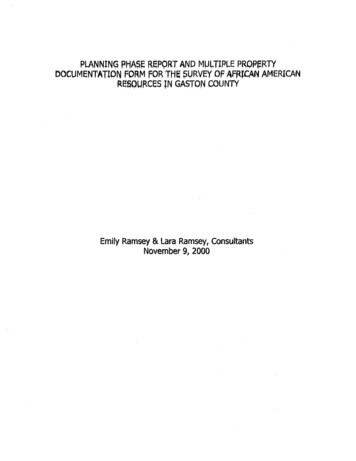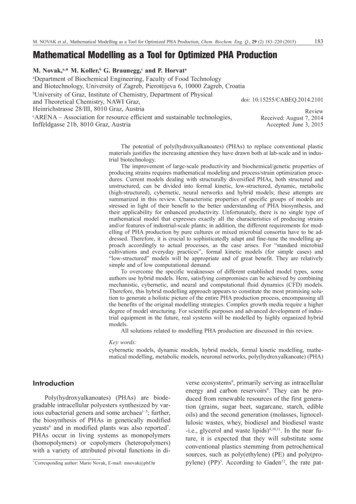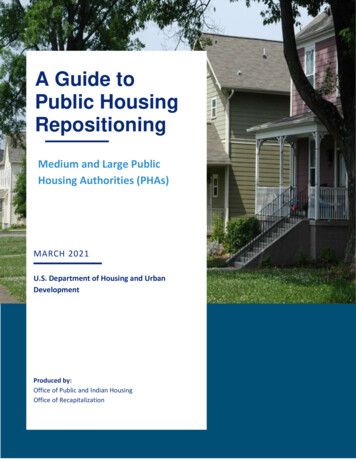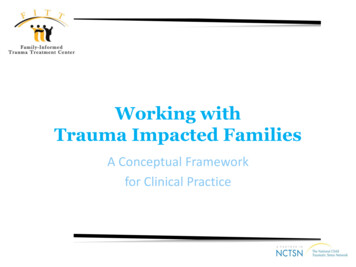
Transcription
PI.ANNING. PHAS R. P9RT AND M TIP(.E PROPt;RTYOOCUMENTAT10N FORM FOR TH SURVE.Y OF AFltlCAN AMERICANRESOURCES IN GASTON COUNTYEmily Ramsey & Lara Ramsey, ConsultantsNovember 9, 2000
PLANNING PHASE REPORTSURVEY OF AFRICAN AMERICAN RESOURCESIN GASTON COUNTYEMILY RAMSEY AND LARA RAMSEY,CONSULTANTSNOVEMBER. 9;20.00 .,,"j.,Introduction and Purpose Statement(,,-:"In 1982, Gasto11 :ounty completed "The Architectural Heritage of Gaston County,.North Carolina," a project intended to serve as a comprehensive :inventory of storicarchitectural resources in Gaston County. While this inventory has served as the basis ofthe Gaston County Historic Preservation Commission's educatiomil programs, localhistoric landmark designations, JlIld National Register noniliiations for the past twoi:"'.-,decades, it is apparent that the inventory is sorely lacking in African American resources.Furthermore, increasing development in the county hasbeenespeci lly damaging toformerly intact historic African American communities,Pllrtictilarly in the city ofGastonia. This countyWide African American ResourcesSurvey, therefore, will serveseveral purposes:1. Document buildings, including both urban and ruralproperties, which arerepresentative of the African American built environment in Gaston County fromapproximately 1880 to approximately 1960.2. Serve as a supplement to the original 1982 county vehtory, "The Architectural··Heritage of Gaston County, North Carolina," pteparedbr: Kim Withers Brengle.3. Serve as a tool that can be used to educate countyandtltyofficials, civic groups,,{.''":,,'.'and the public about African American resourcesinGa tonCollllty and theimportance of sympathetic modernization and de\Telophlept in historically Afri an,. ;American communities.'f
24. Serve as a guide for the Gaston County Historic Preservation Commission innominating African American resources as individual Local Historic Landmarks,in the formation of African American Local Historic Districts, and in identifYingproperties eligible for the National Register of Historic Places.Methodology and Problems of ResearchFor the purposes of this project, the investigation and documentation of AfricanAmerican Resources in Gaston County will be generally divided into urban communityproperties and rural properties. Although some African Americans were scatteredthroughout the county on farms and in small crossroads communities centered around achurch or school, African Americans living in the city of Gastonia and in surroundingsmaller towns of the county lived mainly in segregated communities, typically separatedfrom white communities by such physical boundaries as railroad tracks or commercialcorridors. Taking this into account, the project will begin with documentation of theseconcentrated urban communities and progress outward towards the more rural areas ofthe County.Any survey that focuses on the built environment of a specific group presentsunique challenges to the surveyors, and this project has revealed several commonproblems associated with researching and surveying African American sites. The mostobvious problem in the early phases of research concerned the completion of a traditionalwindshield survey as a means of estimating the number of resources in the county. Sinceit is often impossible to differentiate African American housing, schools, churches,businesses and farms from white structures by physical appearance alone, more in-depthinitial research (utilizing city directories, Sanborn maps, census records, local histories,
3and interviews with several African American community members throughout thecounty) was necessary to pin-point areas that contain African American resources.Windshield surveys were then completed for each of these areas in order to ascertain thenumber of African American resources in each community. The discovery of AfricanAmerican rural properties will rely on further ongoing research of primary and secondarysources in conjunction with oral histories and interviews with local contacts, and will beincluded in the survey as they are uncovered.Researching Gaston County's African American resources is also made difficultby the lack of written records kept on African Americans and by the general lack of localhistories on African Americans in the county. The county's numerous local histories, andthe large number of short written histories on the individual communities within thecounty, generally exclude African Americans, although a few do include shortbiographies of outstanding black citizens or a brief overview of the area's AfricanAmerican history (such as Gastonia Centennial, 1877-1977: A Commemorative Book andBetween Two Rivers - a history of Belmont written to celebrate the city's centennial). Todate, only one book has been published that documents exclusively the history of aGaston County African American community - the recently published Footprints on theRough Side of the Mountain, written by Belmont natives Oscar DePriest Hand, Sf. andJulia Neal Sykes. Therefore, oral histories and interviews (scheduled, impromptu duringfieldwork, and by telephone), along with Sanborn maps and city directories (invaluablefor their information on African American housing, churches, and businesses in Gastonia,but not applicable to the rest of the county) become the most important sources for thissurvey. The local contacts for this survey will serve as invaluable sources of information
4on the area's African American communities - former and current residences provide,along with specific information on particular resources, a sense of the larger picture ofhow African Americans lived in Gaston County. Several contacts will also be needed toserve as guides during fieldwork, particularly in towns outside of Gastonia and in ruralareas, where City Directories and other valuable printed resources are not available.Criteria For Evaluating ResourcesFor this project, several criteria will determine which African American resourceswill be map-coded, which will be surveyed using North Carolina green (multiplestructures) data sheets, and which are important enough, historically or architecturally, tomerit North Carolina yellow (short individual) data sheets. Integrity ofthe structure(particularly the extent to which the structure has retained its original appearance), theimportance ofthe structure in the fabric of the African American community, andrepresentativeness of form and design will serve as the main criteria for evaluating theseresources. The vast majority ofthe structures will be documented using multiplestructures data sheets. Isolated resources, resources in urban or rural communities thatare particularly pristine representative examples or historically or architecturallysignificant examples of African American houses, churches, and businesses, andstructures significant to the entire African American community in Gaston County (suchas the county's first and second black hospitals) will be documented using North Carolinayellow (short) data sheets. Resources within the county's urban communities that appearto be fifty years old or older, but which have been significantly altered or appear to bepoorly preserved exampled of common forms, will be map-coded.
5Quality and Quantity of ResourcesThe number and concentration of African American resources in Gaston Countyfollows a predictable pattern. The city of Gastonia (the county seat and the largest city inthe county in both population and physical size) contains the largest number of remainingresources - approximately 400 buildings. Although the majority of these structures aresimple frame houses, the area includes several significant structures, including the largestAfrican American School in the county, the Highland High School, and St. Stephen's A.M. E. Zion Church. Belmont, to the east of Gastonia, contains approximately 200resources, including several black-owned businesses, a teacherage that served the allblack Reid High School, and a black-owned and operated cafe. The county's smallercities and towns, such as Mount Holly, Dallas, Bessemer City, Cherryville and Stanley,contain far fewer resources, an average of20-30 buildings in each town, usuallysurrounding an African American church or a school building constructed to serve blackstudents. Smaller towns like McAdenville, Cramerton and Spencer Mountain, many ofwhich began as late nineteenth-and early-twentieth- century mill villages, are expected toyield only around 5-10 properties each.Several rural African American churches have been identified, and it is expectedthat more rural resources - mostly churches and schools - will appear as researchprogresses. In evaluating these rural resources, the surveyors will take into considerationsuch factors as the age (generally fifty years or older), the condition, and the integrity ofeach structure (the extent to which the structure has retained its original appearance); inaddition to these basic criteria, such factors as the structure's immediate surroundings (in
6particular, the extent to which the original rural setting of the structure has beenpreserved) will decide whether a rural structure merits a yellow data sheet. An average of10-15 files for rural resources will serve as the official estimate for this planning phaseand for the Time-Product-Payment Schedule, with the understanding that the finalnumber of rural resources surveyed may differ from this estimation, and will bedetermined in consultation with the Historic Preservation Office.Architecturally, it appears that African American resources differ very little fromthe architecture of the majority of white communities in Gaston County. Housing is, withfew exceptions, modest one-story, gable-roof, frame structures closely resembling thearchitecture of the dozens ofmill villages dotting the county. Buildings containing blackowned and operated commercial enterprises (most often a small grocery or general store)consist mainly of small, plain brick, frame, or cinderblock one-room structures. Extantblack churches in the County are overwhelmingly brick structures of varying plans, andmost of the schools thus far identified are modem brick-veneered buildings, many datingfrom the early to mid-1950s.The majority of these resources, as stated above, will be documented usingNational Register green (multiple structures) data sheets. Each file will include acompleted historic structures data sheet, a brief historical and architectural background onthe area covered, an inventory that includes a brief description of each resources, blackand white photographs on enlarged contact sheets, a sketch of the properties, and aSanborn map of the area where possible.Cities and TownsGastoniaBelmontLowellRanlo
7Mt. HollyBessemer CityCherryvilleDallasStanleyHigh ShoalsMcAdenvilleCramertonSpencer MountainTotal Number of ResourcesAltogether, the survey of Gaston County's African American resources willdocument (through map-coding and completion of National Register green and yellowforms) approximately 810-900 resources from the county's fourteen cities and towns inapproximately 80-90 files, and approximately 10-15 files (subject to change with furtherresearch) on individual properties in the rural portions of the county.Geographic and Natural Characteristics of Gaston CountyGaston County is situated in the western piedmont region of North Carolina,spanning an area of357 square miles and encompassing fourteen incorporatedmunicipalities. Established in 1846 from land previously contained by Lincoln County,Gaston County is largely a land of rolling hills, broken by the Kings Mountain chain andby Crowders Mountain in the southwest region of the county. Local historians Robert F.Cope and Manly Wade Wellman write of Gaston County as a "rolling, hilly country,tufted with forests of pine and hardwood, patched with field and meadows, and crisscrossed with streams -looked westward to the haze-crowned foothills of the BlueRidge."l While twentieth-century development has overtaken many of the county'soriginal forests and covered many of the open fields and meadows, the area retains itsclay soil, which once supported corn, wheat and cotton, as well as a good portion of itsgently rolling hills, surprisingly impressive mountains, and woodlands. More important1 RobertF. Cope and Manly Wade Wellman, The County of Gaston: Two Centuries of a North Carolina
8than any other of Gaston County's natural geographic features is the network of riversand fast-running shallow streams that criss-cross the county - the Catawba River, theSouthfork Catawba River, Long Creek, and numerous smaller waterways contain theflowing water that powered Gaston County's first textile mills.Historical Development and Principal Historical ContextThe principal context listed in the North Carolina State Historic Preservation Office's"Handbookfor Completing Historic Structures Form" that applies to this survey is,obviously, "Black Heritage." This section includes a brief history of the development ofthe black community in Gaston County, concentrating on the late 1800s and the first halfof the twentieth century.SettlementIn general respects, the early history of Gaston County mirrors that of most otherareas of the North Carolina Piedmont. First inhabited by the Catawba Indians, whosettled primarily along the western shoreline of the Catawba River, the land that wouldbecome Gaston County experienced its first significant white immigration during thelatter part of the eighteenth century, when large numbers of German and Scots-Irishsettlers began moving south from Pennsylvania into the North Carolina Piedmont,attracted mainly by the plentiful, inexpensive land available in the area. Once theyarrived, these settlers discovered that the land in the Piedmont would be difficult to farmprofitably. Gaston County settlers faced hard red clay soil, a growing season that wassignificantly shorter than in the eastern part of the state, poorly maintained roads, andlargely unnavigable waterways. Consequently, farms that developed in the area wererelatively small and, by necessity, self-sufficient. 2Region (Gaston County Historical Society: 1961), p.l.Kim Withers Brengle, The Architectural Heritage o/Gaston County, North Carolina (County of Gaston,1982), p. 3.2
9Antebellum-PeriodThe German and Scots-Irish origin of Gaston's early settlers would later become amajor factor in the African American history of the county, as the South becameincreasingly dependent on slave labor and a plantation economy. Eli Whitney's cottongin, designed in 1793, made cotton farming a profitable option for many areas oftheSouth, but the land ofthe North Carolina Piedmont and the attitude of its inhabitants werenot conducive to large scale-farming with the assistance of slave labor. The Piedmont'slargely pietistic German population, Kim Withers Brengle argues, was "culturally andreligiously oriented away from slaveholding.,,3 Thus, the area that would later becomeGaston County continued the agricultural pattern of small farmsteads utilizing primarilywhite labor that had been established by the region's first white settlers. In 1860, GastonCounty had 2,199 slaves and 360 slaveholders - ranking thirtieth among the 87 NorthCarolina counties in number of slaves, and holding only a third as many slaves asneighboring Mecklenburg County.4Although the antebellum period saw Gaston County continuing in the agriculturaldirection that its residents had set a century earlier, several events laid the foundation forthe County's industrialization and tremendous growth in the post-war period. Just twoyears after the official establishment of Gaston County in 1846, the Mountain Island Millbegan operation on the Catawba River as the first textile mill in the County. In 1852, asecond textile operation, the Woodlawn ("Pinho ok") Mill, opened on the Southfork Rivernear present day McAdenville. The following year, Larkin Stowe and his sons, Jasper,W.A., and Edward B., built Stowe's Factory on the Southfork River, south of the34Ibid, p.3-4.Ibid. United States Historical Census Data Browser, Total Slave Population and Total Number of
10Woodlawn Mill. Within a span of five years, Gaston County had moved fromexclusively an agricultural region to a fledgling manufacturing center, producingprimarily cotton yarn. In 1860, the Wilmington, Charlotte and Rutherford Railroadcompleted a rail line through the county, and Gaston County suddenly had access toagricultural and commercial centers and to distant markets. 5Reconstruction and IndustrializationThe end of the Civil War signaled the beginning of a new era for the youngcounty of Gaston and for many surrounding counties in the Piedmont. The newlycompleted railroad networks in the area were largely untouched by the war's destruction,and Gaston County was able to profit from post-war conditions. By 1874, textile millswere again being constructed in the county, and after 1880, industrial growth in theregion rose exponentially. Textile mills utilizing steam power began cropping upalongside the growing network of rail lines crossing the county. Gastonia, a small depottown before the Civil War, quickly became the industrial center of Gaston County and, in1911, also became the county seat. 6 Gaston County, by 1900, led the state in bothnumber of mills and number of spindles, a position it held through the 1920s. Gastonbecame known as ''the combed yarn capital ofthe world." 7The prosperity that textiles brought to Gaston County attracted not only whitefarmers throughout North and South Carolina - it was also during this period that GastonSlaveholders, 1860 (www.fisher.lib.virginia.edulcensusl).Sally Griffm, Gaston Remembers: Weaving a Tapestry in Time (Gaston County Chamber of Commerceand Community Communications: Montgomery, Alabama, 1994), p.31-35.6 Jim Atkins, ed., Gastonia Centennial: 1877-1977 Commemorative Book (Gastonia CentennialCelebration, Inc.: 1977), p.3-4.7 Thomas W. Hanchett, "Charlotte's Textile Heritage: An Introduction" (Charlotte-Mecklenburg HistoricLandmarks Commission), p.3.5
11County's black population experienced significant growth. The "colored" population ofthe county doubled between 1880 and 1900 - from 4,066 persons to 8,118 persons. 8Former slaves and their descendents still living in the county worked mainly on farms astenant farmers and sharecroppers until the turn of the century. By the tum of the century,only eighty-four of the county's 540 black farmers owned their own farmsteads.,,9However, as the cities and towns in the county swelled in population and developeddiverse commercial and industrial districts, African Americans moved in to takeadvantage of the opportunity for jobs. All but the dirtiest, most physically demanding ofthe mill jo bs were reserved for white workers, but blacks found jo bs in cities and towns,primarily as domestic workers and laborers. They began building their ownneighborhoods on the edges of city and town limits, complete with churches, meetinghouses, small businesses, and schools.Despite the constraints and suppression caused by racial discrimination andsegregation, blacks in Gaston County developed rich and diverse communities during thelate 1800s and the early 1900s. Gaston County's African American population followedthe three themes of the black experience after 1877 outlined by historian Jeffrey J. Crowin A History ofAfrican Americans in North Carolina: "organization, uplift, andincreasing diversity."lo They congregated in Baptist, A. M. E. Zion, and Presbyterianchurches, gathered together under fraternal organizations and social clubs, formed theirown community schools, and promoted black-owned and operated businesses - all of8United States Historical Census Data Browser, Negro Population, 1880 and Jeffrey 1. Crow, A History ofAfrican Americans in North Carolina (North Carolina Division ofArchives and History, 1992), p.96-97.
12which served to boost morale in the black community and promote educational, spiritual,and commercial progress.The accomplishments of Gaston County's black communities, which promotedgrowth and progress in the late 1800s, would be challenged in the twentieth century withthe advent of Jim Crow laws. After the 1900 passage of a constitutional amendmentwhich effectively stripped blacks oftheir right to vote, white politicians in North Carolinaand across the South passed a flurry of discriminatory legislation and effectivelysegregated African Americans in "every phase of life, from birth to death, stigmatizingthem as a despised and inferior race."" Gaston County's cities and towns becameincreasingly segregated as a result. The Highland Neighborhood in Gastonia, whichconsisted only ofa few small streets flanking N. York St. at the tum of the century (theHighland High School, one of the centers ofthe Highland community, drew a majority ofits students from outside its own neighborhood), grew exponentially during the age ofJim Crow. With no other options open to them, blacks in Gastonia moved intoHighland's ever-expanding rows of small frame housing in droves. By 1940, theneighborhood was the largest black community in Gaston County, and it was completelysegregated.Post-World War IIThe decades following World War II were a tumultuous and exciting time forAfrican Americans across the country, as the Civil Rights Movement began loosening thegrip of segregation and discrimination in the South. In Gaston County, however, blackssaw little real change in the rigidly segregated conditions within the city of Gastonia and
13surrounding areas until years later. In Gastonia, the city maintained separate schools,hospitals, and recreational facilities for whites and blacks well into the 1960s. AshleyHigh School, Gastonia's largest public school, was not desegregated until 1967. Anumber of all-black schools, including Lincoln High School in Bessemer City, JohnChavis High School in Cherryville, and Highland Jr. High School in Gastonia wereerected years after Brown vs. Board of Education officially ended the system of. ill. sch00 1s. 12segregationEven today, the areas in Gaston County cities and small towns that werehistorically occupied by African Americans are still primarily black neighborhoods.Boundaries are no longer rigidly defined, as African American occupants have nowspread across former physical boundaries (most often, railroad tracks) that separatedwhite and black communities. Churches still form the center ofthese communities;however, once proud (ifmodest) houses, businesses, schools, and commercial districtsare now, with few exceptions, in varying stages of alteration or deterioration. Much ofthis deterioration seems to be the result of outward migration of the younger generationswho grew up in these communities. Increased job opportunities, new housing incomfortable suburbs, and the desire to get away from neighborhoods formed during theage of Jim Crow and legalized segregation have drawn successful baby boomer AfricanAmericans and their children out of these historically black communities. In Gastonia,the deterioration of the city's downtown district and the movement of commercial andindustrial enterprises east (closer to the metro Charlotte area) have also contributed to aIbid, p.117.Oscar DePriest Hand, Sr. and Julia Neal Sykes, Footprints on the Rough Side a/the Mountain (Hand andSykes Concepts, 1997), p.121-122. Vertical Files entitled "African American History" located in the NorthCarolina Collection, Gaston County Public Library, Main Branch.II12
14widespread decline in the Highland community. Outward migration is, however, onlyone part of the explanation behind the deterioration of Gaston County's AfricanAmerican communities. This topic, which forms an important part of the larger pictureof African Americans in Gaston County, will be more fully explored as the surveyprogresses.
15Annotated Bibliography of SourcesSelected Secondary SourcesHand, Oscar DePriest, Sr. and Sykes, Julia Neal. Footprints on the Rough Side of theMountain: An African American Niche in the History of a Southern Textile City.Charlotte: Hand and Sykes Concepts, 1997.The only known written history concentrating exclusively on African Americansin the area of Gaston County. The authors tell the history of the black community inBehnont in an informal way, but their research gives valuable information about AfricanAmericans in Gaston County and about the African American communities (includingthe built environment) ofBehnont.Crow, Jeffrey J., Escott, Paul D., and Hatley, Flora J. A History ofAfrican Americans inNorth Carolina. Raleigh: North Carolina Division of Archives and History, 1992.An informative comprehensive history of African Americans across the state,particularly useful in discerning how events in the history of Gaston County's AfricanAmerican population compare to other areas of the state from the colonial period to themid-twentieth century.Atkins, Jim, editor. Gastonia Centennial: 1877-1977 Commemorative Book. GastoniaCentennial Celebration, Inc. 1977.Valuable for a brief but instructive section on African Americans in Gastonia,which mainly consists of a list of "great" black citizens and their accomplishments,including many "firsts"- first black reporter for the Gastonia Gazette, first elected Justiceof the Peace in Gastonia, etc.Cope, Robert F. and Wellman, Manly Wade. The County of Gaston: Two Centuries of aNorth Carolina Region. Gastonia, NC: Gaston County Historical Society, 1961.A good general history of the County, helpful for background information onevery aspect of Gaston County from the early 1700s to the early twentieth century. Itdoes not, however, contain any black history, and some of the views on certain aspects ofGaston's history are dated and subjective.Separk, Joseph. Gastonia and Gaston County, North Carolina: Past, Present and FutureKingsport Press, Inc. 1936.Basically a compilation of facts on Gaston County, very helpful for findinginformation on specific aspects of life in Gaston County in the early twentieth centuryreligion, education, industrial, etc. No information on African American community.
16Brengle, Kim Withers. The Architectural Heritage of Gaston County, North Carolina.Gastonia, NC: County of Gaston, 1982.Gives a good idea of what African American resources have already beeninvestigated in the county. Few are included, and all but one are churches.Henry, Phillip N. and Speas, Carol M. The Heritage of Blacks in North Carolina, Vol. 1.Raleigh: North Carolina African American Heritage Foundation, 1990.Collection of articles, stories, family histories, and photographs, with a conciseintroductory history of African Americans in North Carolina.Selected List of Primary Sources1. United States Census Records, Gaston County, 1790-1960.On microfilm at the North Carolina Room, Public Library of Charlotte andMecklenburg County, Main Branch and online atwww.fisher.lib.virginia.edulcensus/.2. Gastonia City Directories, 1911-1965.Bound volumes available in the North Carolina Collection of the Gaston CountyPublic Library, Main Branch.3. Vertical Files entitled "African American History - Gaston County" - includesprimarily newspaper articles from the Gastonia Gazette and other local papers,dating from the mid-1940s through the 1970s.4. Sanborn Fire Insurance Maps 1895-1930, Gaston County.North Carolina Collection ofthe Gaston County Public Library, Main Branch.Contacts for Selected Areas of the CountyGastonia area:Mildred Sadler, James Miller, Rossie Saunders, RosettaLightner, Arleva Rainey, Julia Price, Thelma Vance,Lindora SmithBelmont:Elsie Grier, Julia Sykes, Jethro Mann, Madge RozellCherryville:Camilla YoungBessemer City:Tweetie StewartDallas:George JaggersMount Holly:Herman GregoryCrowders Mt.:Ruth McDowell, Cynthia Simpson, Jim BiggersStanley/Springfield: William Luckey, Jane Brown Patrick, Caroll Saunders
17TIME - PRODUCT - PAYMENT SCHEDULESurvey of Gaston County's African American ResourcesEmily Ramsey and Lara RamseyPRODUCTCOMPLETIONDATECOSTDecember 9, 2000 600.00Continue Research for Possible Rural Properties,Developmental History/Context, and Community HistoriesFieldwork - Gastonia Community, East Side: including photographyand creating forms. Approximately 200 properties will be documented onapproximately 18 - 20 green forms. 10-20 properties may merit individualyellow forms.Submit Five Sample Files for ReviewFieldwork - Gastonia Community, West Side; Lowell and RanloCommunities: Approximately 215 properties will be documented onapproximately 20 green forms. 10-20 properties may merit individual yellow forms.File Completion - Gastonia, East Side: including photo/slide/negative labeling &creating files. 740.00January 9, 2001February 9, 2001 740.00March 9, 2001 740.00April 9, 2001 740.00Fieldwork - Rural Properties: rough estimate (at end of planning phase) of about10-15 yellow forms, subject to change as research progresses.File Completion - Bessemer City, Cherryville, Stanley, Dallas, High Shoals,Cramerton, Spencer Mountain, and McAdenvilleMay 9, 2001 740.00Complete research for MPDF and produce first draft of MPDF; begindetermining properties to be recommended for the Study List.File Completion - Rural PropertiesJune 9, 2001 1,000.00Create final survey mapsComplete Study List recommendationsand make presentations to NRACJuly 9,2001Fieldwork - Belmont and Mount Holly Communities: Approximately 225properties will be documented on approximately 22 green forms. Approximately10-20 Belmont properties will be documented using individual yellow forms.File Completion - Gastonia, West Side; Lowell & RanloFieldwork - Bessemer City, Cherryville, Stanley, Dallas, High Shoals,Cramerton, Spencer Mountain, and McAdenville communities: Approximately120 properties on approximately 15 green forms. Approximately 5-10 resourceswill be documented usi
African American School in the county, the Highland High School, and St. Stephen's A. M. E. Zion Church. Belmont, to the east of Gastonia, contains approximately 200 resources, including several black-owned businesses, a teacherage that served the all black Reid High School, and a black-owned and operated cafe. The county's smaller










